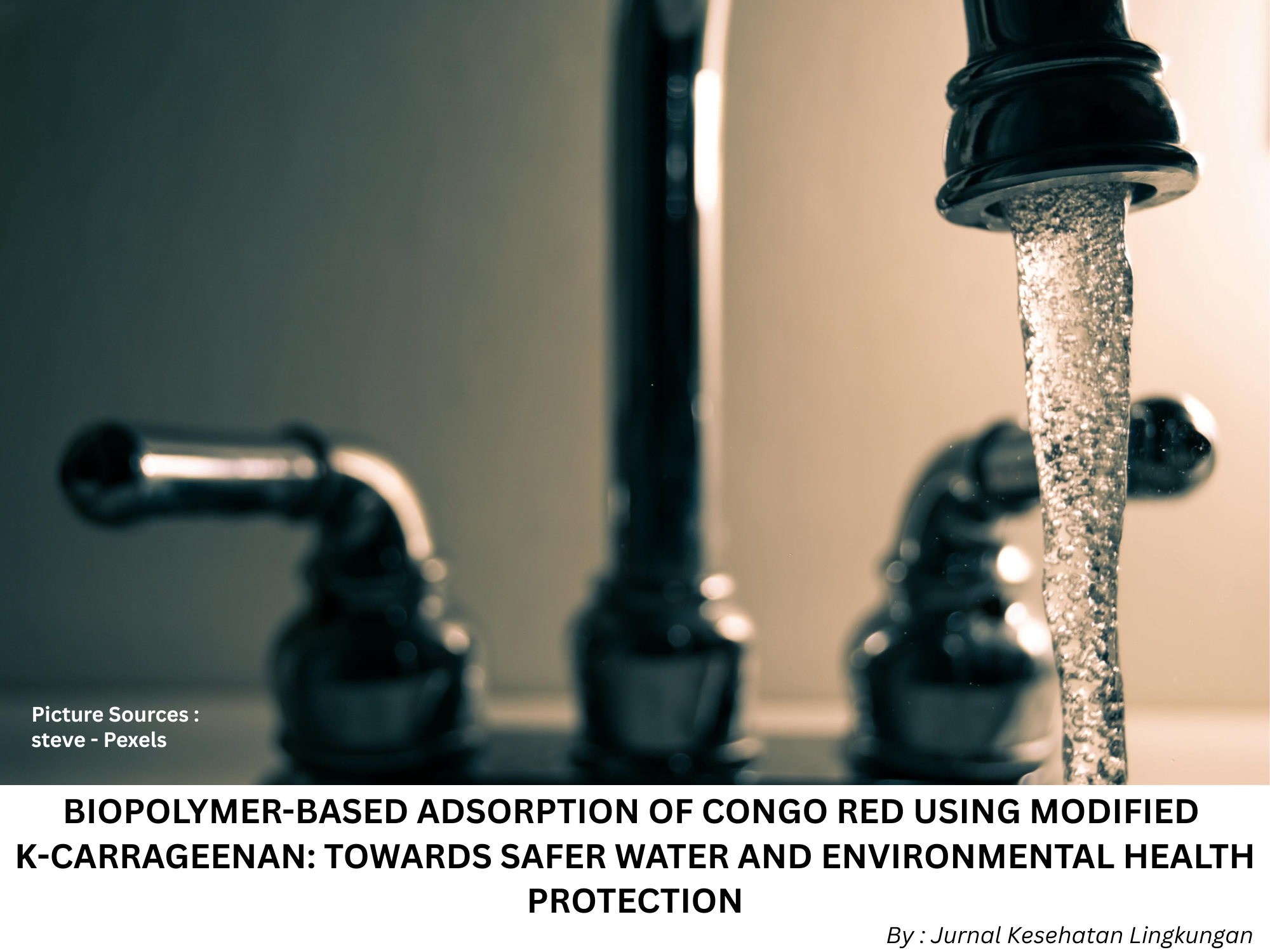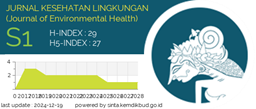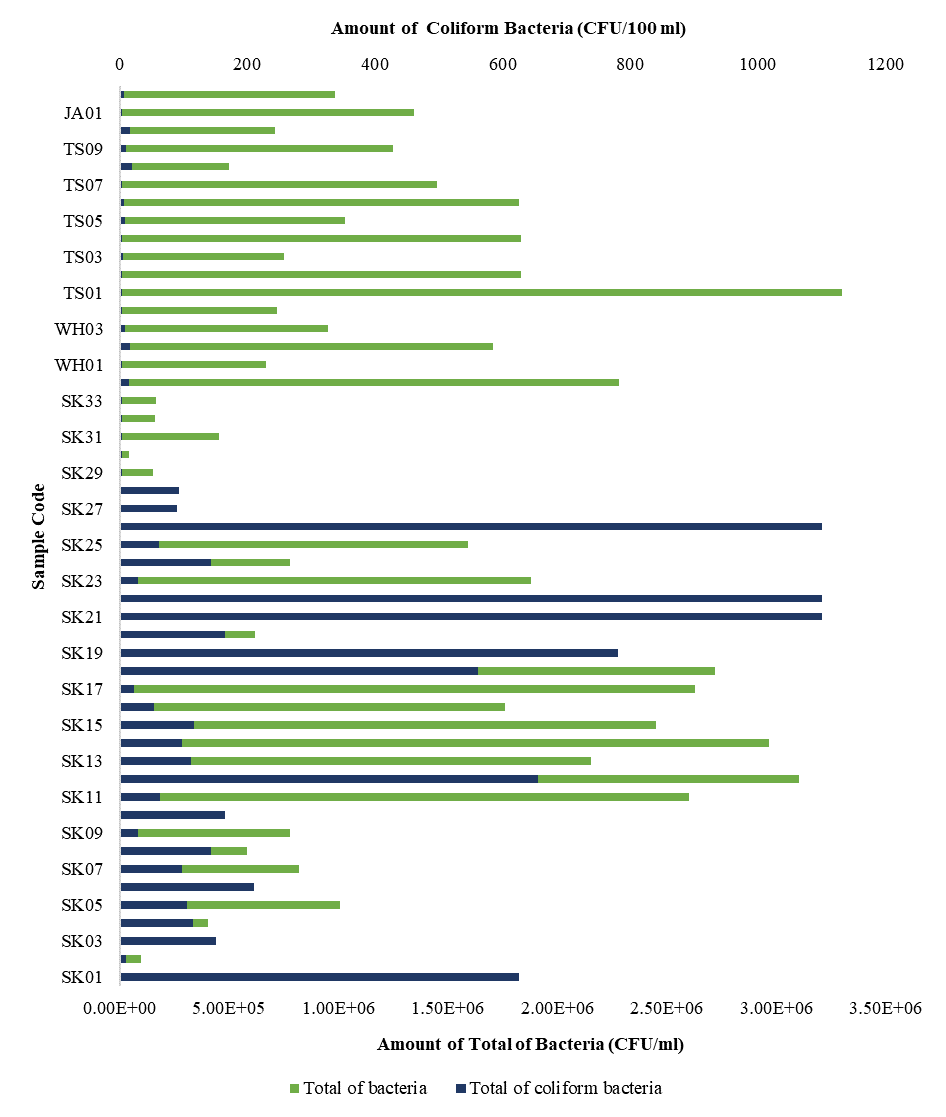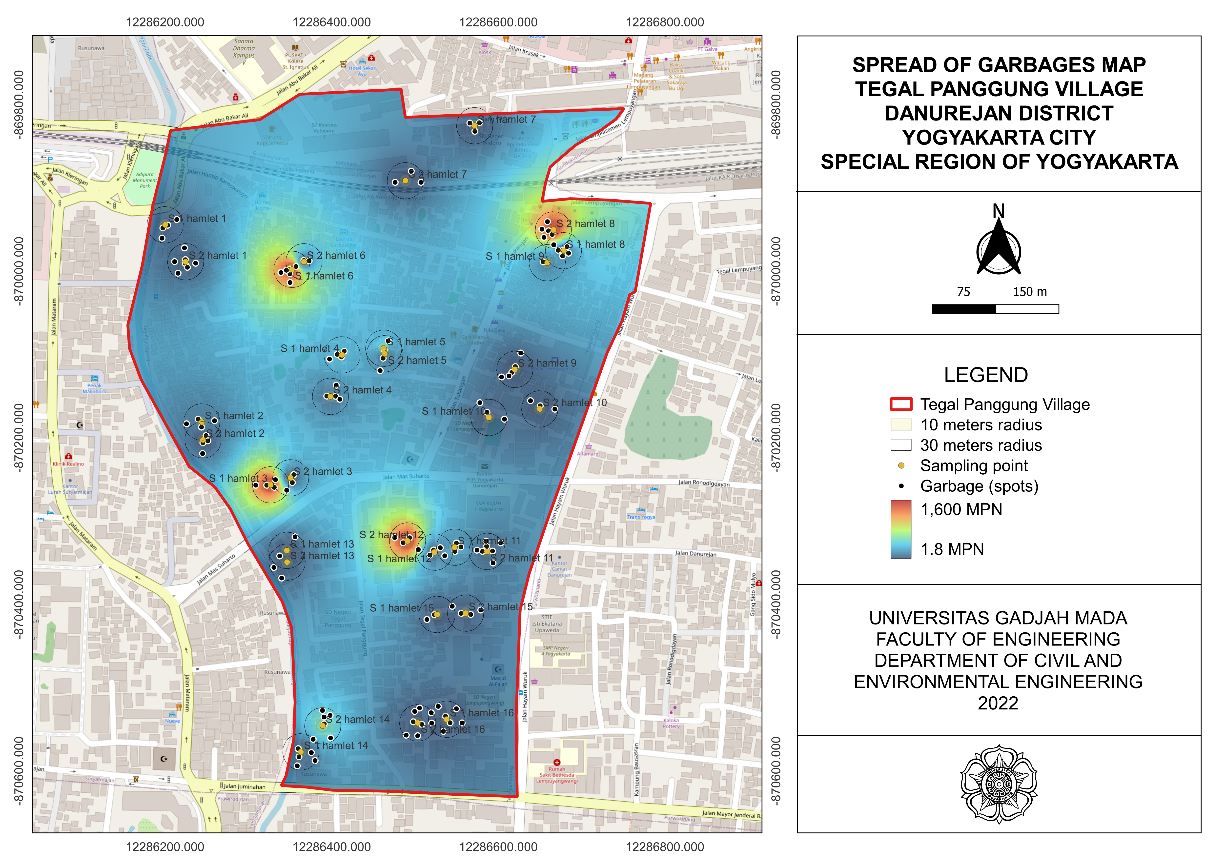Biopolymer-Based Adsorption of Congo Red Using Modified Κ-Carrageenan: Towards Safer Water and Environmental Health Protection

Downloads
Introduction: The discharge of synthetic dyes such as Congo Red (CR) into water systems poses serious threats to aquatic biodiversity, deteriorates water quality, and raises public health risks due to their toxicity, persistence, and tendency to bioaccumulate. This study investigates the potential of chemically modified κ-carrageenan as a biosorbent for CR removal under varying conditions. Methods: Two forms of κ-carrageenan were prepared: unmodified (κC) and modified (mκC). Functional groups were identified using Fourier Transform Infrared Spectroscopy (FTIR), while surface morphology was examined via Scanning Electron Microscopy (SEM). Batch adsorption experiments were conducted to assess how dye concentration, contact time, and adsorbent amount affect Congo Red removal, measured by UV-Vis spectrophotometry and analyzed using Langmuir and Temkin isotherm models. Results and Discussion: The mκC achieved 93.3% removal efficiency at an initial CR concentration of 20 mg/L, reaching equilibrium within 60 minutes at an optimal dosage of 0.3 g. FTIR confirmed the presence of functional groups such as carbonyl, sulfonate, and amide. SEM revealed an increase in the biosorbent's roughness and porosity. Isotherm modelling showed a strong fit to the Langmuir model, with an R² value of 0.9974 and a maximum adsorption capacity of 476.19 mg/g. The Temkin model also revealed a good correlation (R²=0.9511), indicating that chemisorption is the primary mechanism of adsorption. Conclusion: Modified κ-carrageenan is a cost-effective and biodegradable biosorbent for dye removal, with potential for wastewater treatment. Future research on regeneration and real-world applications will enhance its role in improving water quality and protecting environmental health.
Raharjo Y, Darmokoesoemo H, Julia A, Fetty T, Aziz RA, Salsabila F, et al. Cellulose Nanocrystals Based on Pineapple Leaf Fibers in Hemoperfusion Applications for Creatinine Removal: Batch Method Adsorption Study. Jurnal Kimia Riset. 2024;9(2):163-181. https://doi.org/10.20473/jkr.v9i2.65046
Hernández-Zamora M, Martínez-Jerónimo F. Congo Red Dye Diversely Affects Organisms of Different Trophic Levels: A Comparative Study with Microalgae, Cladocerans, and Zebrafish Embryos. Environmental Science and Pollution Research. 2019;26(12):11743–11755. https://doi.org/10.1007/s11356-019-04589-1
Radoor S, Kassahun SK, Kim H. Selective Adsorption of Cationic Dye By Κ-Carrageenan-Potato Starch Bio-Hydrogel: Kinetics, Isotherm, And Thermodynamic Studies. Int J Biol Macromol. 2024;281(136377):1-14. https://doi.org/10.1016/j.ijbiomac.2024.136377
Jesi AA, Feisal NAS, Windusari Y, Samat NA, Kamaludin NH, Derahim N, et al. Klang River Water Quality Assessment and its Effects on Human Health Using Chemometric Analysis. Jurnal Kesehatan Lingkungan. 2024;16(2):125–136. https://doi.org/10.20473/jkl.v16i2.2024.125-136
Mulyati TA, Pujiono FE, Indah I. The Exposure of Pb to Hair and Nails in Children Around “X” Coal Mines Using Atomic Absorption Spectroscopy (AAS) Method. Jurnal Kesehatan Lingkungan. 2021;13(3):174–179. https://doi.org/10.20473/jkl.v13i3.2021.174-179
Kabir ASF, Kanadasan G, Lee KT, Vadivelu VM. Insight Into Recent Advances in Microalgae Biogranulation in Wastewater Treatment. Crit Rev Biotechnol. 2024;44(8):1594–1609. https://doi.org/10.1080/07388551.2024.2317785
Zubaidah T, Hamzani S, Arifin A. Analyzing the Impact of Dissolved Organic Components on River Water Quality and its Implications for Human Health: A Case Study from Banjar District. Jurnal Kesehatan Lingkungan. 2024;16(2):181–189. https://doi.org/10.20473/jkl.v16i2.2024.181-189
Nurika G, Indrayani R, Syamila AI, Adi DI. Management of Pesticide Contamination in the Environment and Agricultural Products: A Literature Review. Jurnal Kesehatan Lingkungan. 2022;14(4):265–281. https://doi.org/10.20473/jkl.v14i4.2022.265-281
Aziz AA, Osman MS, Rasdi NW, Shafie FA, Feisal NAS, Zaki MA, et al. Assessing Microplastic Contamination in Shellfish: Insights from Pantai Remis Kuala Selangor, Strait of Malacca, Malaysia. Jurnal Kesehatan Lingkungan. 2024;16(4):321–330. https://doi.org/10.20473/jkl.v16i4.2024.321-330
Pramudinta NK, Sulistyorini L, Rustanti I. Adsorption Kinetics of Banana Stem Activated Carbon in Reducing Phosphate Levels. Jurnal Kesehatan Lingkungan. 2024;16(1):51–58. https://doi.org/10.20473/jkl.v16i1.2024.51-58
Khir NHM, Salleh NFM, Ghafar NA, Shukri NM. Mitigating Health Risks Through Biosorption: Effective Removal of Nickel (II) and Chromium (VI) from Water with Acid-Treated Potato Peels. Jurnal Kesehatan Lingkungan. 2024;16(4):312–320. https://doi.org/10.20473/jkl.v16i4.2024.312-320
Hussain S, Kamran M, Khan SA, Shaheen K, Shah Z, Suo H, et al. Adsorption, Kinetics and Thermodynamics Studies of Methyl Orange Dye Sequestration Through Chitosan Composites Films. International Journal of Biological Macromolecules 2021; 168(12):383-394.https://doi.org/10.1016/j.ijbiomac.2020.12.054
Mirasa YA, Hurhidayati S, Wicaksono RI, Winarko W, Juwono KF, Zakaria ZA, et al. Refill Drinking Water Depot Risk Assessment for Chemical Hazard Contaminant in 25 Cities of East Java Province, Indonesia. Jurnal Kesehatan Lingkungan. 2024;16(2):166–172. https://doi.org/10.20473/jkl.v16i2.2024.166-172
Mussa ZH, Al-Ameer LR, Al-Qaim FF, Deyab IF, Kamyab H, Chelliapan S. A Comprehensive Review on Adsorption of Methylene Blue Dye Using Leaf Waste As A Bio-Sorbent: Isotherm Adsorption, Kinetics, and Thermodynamics Studies. Environmental Monitoring and Assessment. 2023;195(8):1–36. Available from: https://link.springer.com/article/10.1007/s10661-023-11432-1
Saxena M, Sharma N, Saxena R. Highly Efficient and Rapid Removal of A Toxic Dye: Adsorption Kinetics, Isotherm, and Mechanism Studies on Functionalized Multiwalled Carbon Nanotubes. Surfaces and Interfaces. 2020;21(100639):1-10. https://doi.org/10.1016/j.surfin.2020.100639
Rajni, Taruna, Udayasri A, Raghav N, Bendi A, Tomar R. Revolutionizing Wastewater Treatment: Polymeric Metal Oxide Nanocomposites for Effective Dye and Heavy Metal Removal. Chemical Engineering Journal. 2025;511(161694):1-67. https://doi.org/10.1016/j.cej.2025.161694
Bozbay R, Orakdogen N. Tailoring Amino-Functionalized N-Alkyl Methacrylate Ester-Based Bio-Hybrids for Adsorption of Methyl Orange Dye: Controllable Macromolecular Architecture Via Polysaccharide-Integrated Ternary Copolymerization. Int J Biol Macromol. 2022;299(140034):1-27. https://doi.org/10.1016/j.ijbiomac.2025.140034
Yu J, Tian S, Yao A, Hu H, Lan J, Yang L, et al. Compressible Polydopamine Modified Pomelo Peel Powder/poly(ethyleneimine)/κ-carrageenan Aerogel with pH-tunable Charge for Selective Removal of Anionic and Cationic Dyes. Carbohydr Polym. 2024;323(121377):1-17. https://doi.org/10.1016/j.carbpol.2023.121377
Keman S, Hadi MI, Suprayogi D, Mirasa YA. Phylogenetic Analysis and Mutation of Sars-Cov-2 in Bats in Karst Malang City, Indonesia. Jurnal Kesehatan Lingkungan. 2024;16(2):173–180. https://doi.org/10.20473/jkl.v16i2.2024.173-180
Suprayogi D, Utama TT, Hadi MI, Agung TS, Rizqiyah Z. Distribution and Abundance of Microplastics in Underground Rivers in the South Malang Karst Area: First Evidence in Indonesia. Jurnal Kesehatan Lingkungan. 2024;16(2):101–109. https://doi.org/10.20473/jkl.v16i2.2024.101-109
Hao R, Ji H, Gao L, Chen J, Shi Y, Yang J, et al. Grafted Natural Melanin Κ-Carrageenan Hydrogel Bead Adsorbents: New Strategy Bioremediation of Cationic Dye Contamination in Aqueous Solutions. Chemical Engineering Research and Design. 2023; 199:1–10. https://doi.org/10.1016/j.cherd.2023.09.016
Sharma G, Khosla A, Kumar A, Kaushal N, Sharma S, Naushad M, et al. A Comprehensive Review on the Removal of Noxious Pollutants Using Carrageenan Based Advanced Adsorbents. Chemosphere. 2022 1;289(133100):1-22. https://doi.org/10.1016/j.chemosphere.2021.133100
Ulu A, Alpaslan M, Gultek A, Ates B. Eco-Friendly Chitosan/Κ-Carrageenan Membranes Reinforced with Activated Bentonite for Adsorption of Methylene Blue. Mater Chem Phys. 2022;278(125611):1-14. https://doi.org/10.1016/j.matchemphys.2021.125611
Hassan AF, Alshandoudi LM, Awad AM, Mustafa AA, Esmail G. Synthesis of Nanomagnetite/Copper Oxide/Potassium Carrageenan Nanocomposite for the Adsorption and Photo-Fenton Degradation of Safranin-O: Kinetic and Thermodynamic Studies. Macromol Res. 2023;31(7):677–697. http://dx.doi.org/10.1007/s13233-023-00147-4
Hassanzadeh-Afruzi F, Forouzandeh-Malati M, Ganjali F, Mehdi SM, Maleki A, Nazarzadeh ZE. Carrageenan-Grafted-Poly(Acrylamide) Magnetic Nanocomposite Modified with Graphene Oxide for Ciprofloxacin Removal from Polluted Water. Alexandria Engineering Journal. 2023;82:503–517. https://doi.org/10.1016/j.aej.2023.10.011
Hassan AF, El-Naggar GA, Esmail G, Shaltout WA. Efficient Adsorption of Methylene Blue on Novel Triple-Nanocomposites of Potassium Kappa-Carrageenan, Calcium Alginate and Nanohydroxyapatite Obtained from Sea Scallop Shells. Applied Surface Science Advances. 2023;13(100388):1-13. https://doi.org/10.1016/j.apsadv.2023.100388
Kalaiselvi K, Mohandoss S, Ahmad N, Khan MR, Manoharan RK. Adsorption of Pb2+ Ions from Aqueous Solution Onto Porous Kappa-Carrageenan/Cellulose Hydrogels: Isotherm and Kinetics Study. Sustainability (Switzerland). 2023;15(12):1-15. https://doi.org/10.3390/su15129534
Hassan AF, Mustafa AA, Esmail G, Awad AM. Adsorption and Photo-Fenton Degradation of Methylene Blue Using Nanomagnetite/Potassium Carrageenan Bio-Composite Beads. Arab J Sci Eng. 2023;48(1):353–373. http://dx.doi.org/10.1007/s13369-022-07075-y
Alam MZ, Bari MN, Kawsari S. Statistical Optimization of Methylene Blue Dye Removal from A Synthetic Textile Wastewater Using Indigenous Adsorbents. Environmental and Sustainability Indicators. 2022;14(100176): 1-13. https://doi.org/10.1016/j.indic.2022.100176
Lapwanit S, Sooksimuang T, Trakulsujaritchok T. Adsorptive Removal of Cationic Methylene Blue Dye by Kappa-Carrageenan/Poly(Glycidyl Methacrylate) Hydrogel Beads: Preparation and Characterization. J Environ Chem Eng. 2018;6(5):6221–6230. https://doi.org/10.1016/j.jece.2018.09.050
Musarurwa H, Tavengwa NT. Advances in the Application of Chitosan-Based Metal Organic Frameworks as Adsorbents for Environmental Remediation, Carbohydrate Polymers. 2022;283(119153):1-14. https://doi.org/10.1016/j.carbpol.2022.119153
Ihsanullah I, Sajid M, Khan S, Bilal M. Aerogel-Based Adsorbents as Emerging Materials for the Removal of Heavy Metals from Water: Progress, Challenges, and Prospects. Separation and Purification Technology. 2022;291(120923):1-22. https://doi.org/10.1016/j.seppur.2022.120923
Baskar A V., Bolan N, Hoang SA, Sooriyakumar P, Kumar M, Singh L, et al. Recovery, Regeneration and Sustainable Management of Spent Adsorbents from Wastewater Treatment Streams: A review. Science of the Total Environment. 2022;822(153555):1-24. https://doi.org/10.1016/j.scitotenv.2022.153555
Albatrni H, Qiblawey H, Al-Marri MJ. Walnut Shell Based Adsorbents: A Review Study on Preparation, Mechanism, and Application. Journal of Water Process Engineering. 2022;45(102527):1-19. https://doi.org/10.1016/j.jwpe.2021.102527
Sajid M, Asif M, Baig N, Kabeer M, Ihsanullah I, Mohammad AW. Carbon Nanotubes-Based Adsorbents: Properties, Functionalization, Interaction Mechanisms, and Applications in Water Purification. Journal of Water Process Engineering. 2022;47(102815):1-19. https://doi.org/10.1016/j.jwpe.2022.102815
Gkika DA, Mitropoulos AC, Kyzas GZ. Why Reuse Spent Adsorbents? the Latest Challenges and Limitations. Science of the Total Environment. 2022;822(153612):1-16. https://doi.org/10.1016/j.scitotenv.2022.153612
Anastopoulos I, Ahmed MJ, Hummadi EH. Eucalyptus-Based Materials as Adsorbents for Heavy Metals and Dyes Removal from (Waste) Waters. Journal of Molecular Liquids. 2022;356(118864):1-10. https://doi.org/10.1016/j.molliq.2022.118864
Shelke BN, Jopale MK, Kategaonkar AH. Exploration of Biomass Waste as Low Cost Adsorbents for Removal of Methylene Blue Dye: A Review. Journal of the Indian Chemical Society. 2022;99(100530):1-15. https://doi.org/10.1016/j.jics.2022.100530
Narsan VO, Setiawan DA, Rukmana A, Dewi RR, Anjarwati S, Suhendri R. Water Quality Status of Way Batanghari River, Metro City, Lampung Province Based on Water Fit for Consumption Parameters. Jurnal Kesehatan Lingkungan. 2023;15(3):152–160. https://doi.org/10.20473/jkl.v15i3.2023.152-160
Gobi K, Mashitah MD, Vadivelu VM. Adsorptive Removal of Methylene Blue Using Novel Adsorbent from Palm Oil Mill Effluent Waste Activated Sludge: Equilibrium, Thermodynamics and Kinetic Studies. Chemical Engineering Journal. 2011;171(3):1246–1252. https://doi.org/10.1016/j.cej.2011.05.036
Ahmad T, Danish M. A Review of Avocado Waste-Derived Adsorbents: Characterizations, Adsorption Characteristics, and Surface Mechanism., Chemosphere. 2022;296(13406):1-21. https://doi.org/10.1016/j.chemosphere.2022.134036
Dhillon A, Sharma S, Singh N, Kumar D. Use of Core-Shell Nanomaterials as Potential Adsorbents for Fluoride Remediation: Toward A Sustainable Ecosystem. Groundwater for Sustainable Development. 2022;18(100785):1-21. https://doi.org/10.1016/j.gsd.2022.100785
Liu B, Gai S, Lan Y, Cheng K, Yang F. Metal-Based Adsorbents for Water Eutrophication Remediation: A Review of Performances and Mechanisms. Environmental Research. 2022;212(113353):1-14. https://doi.org/10.1016/j.envres.2022.113353
He Q, Zhao H, Teng Z, Wang Y, Li M, Hoffmann MR. Phosphate Removal and Recovery by Lanthanum-Based Adsorbents: A Review for Current Advances., Chemosphere. 2022; 303(134987):1-16. https://doi.org/10.1016/j.chemosphere.2022.134987
Pourjavadi A, Ghasemzadeh H, Hosseinzadeh H. Preparation and Swelling Behaviour of A Novel Anti-Salt Superabsorbent Hydrogel Based on Kappa-Carrageenan and Sodium Alginate Grafted with Polyacrylamide. E-Polymers. 2004;027:1-13; https://doi.org/10.1515/epoly.2004.4.1.275

This work is licensed under a Creative Commons Attribution-NonCommercial-ShareAlike 4.0 International License.
1. Copyright of all journal manuscripts is held by the Jurnal Kesehatan Lingkungan.2. Formal legal provisions to access digital articles of electronic journal are subject to the provision of the Creative Commons Attribution-ShareAlike license (CC BY-NC-SA), which means that Jurnal Kesehatan Lingkungan is rightful to keep, transfer media/format, manage in the form of databases, maintain, and publish articles.
3. Published manuscripts both printed and electronic are open access for educational, research, and library purposes. Additionally, the editorial board is not responsible for any violations of copyright law.
JKESLING by UNAIR is licensed under a Creative Commons Attribution-ShareAlike 4.0 International License.







































